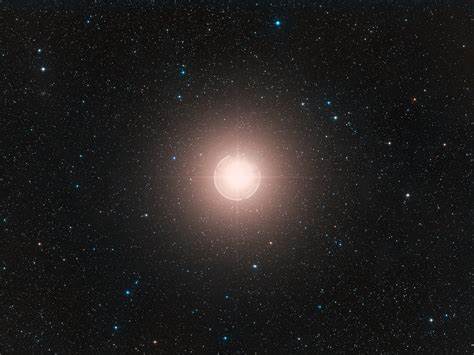This episode is sponsored by Audible.
本期节目由Audible赞助播出。
To get started, go to audible.com/scishowspace or text “scishowspace” to 500 500.
可以浏览audible.com/scishowspace官网或者输入文本scishowspace来了解。
If you've ever looked up at the night sky, you've probably noticed the constellation of Orion the hunter, whose one shoulder is marked by a bright red star called Betelgeuse.
如果你曾仰望夜空的话,你大概会注意到猎户座,猎户座的箭头有一颗闪亮的红色恒星,叫做猎户座α星。
It's one of the most recognizable stars in the night sky.
这是夜空中最有辨识度的恒星之一。

The thing is, these days, it's starting to look a little funny.
问题是:近来,这颗恒星看起来有点有趣了。
It's always been super bright because it's just 650 light-years away and it's mind-bogglingly big.
它总是特别亮,因为它距离我们只有650光年,大得让人难以置信。
Seriously, our solar system out to Jupiter would fit inside of it.
不夸张地说,它能装得下太阳系里的木星。
That tells us this star is a red supergiant, meaning it's at the end of its life, and scientists believe it's the closest star to Earth ready to explode in a massive supernova.
这就告诉我们——这颗恒星是一颗红色超大恒星,已经处于生命的尽头。科学家认为,这颗恒星距离即将发生大规模超新星的恒星中距离地球最近的那一个。
But since last year, scientists have noticed that Betelgeuse is dimming, and not just a little. It's gone from the 11th-brightest star in the sky to the 24th.
不过,自去年以来,科学家注意到,这颗恒星的亮度在减弱,而且减弱得程度不是一点半点。它曾经在天空中最亮恒星的排名中位列11,但现在已退居24位。
That's enough to notice with the naked eye!
这种变化是肉眼可见的!
And just last week, thanks to observations from the European Southern Observatory, we learned that this dimming is kind of lopsided.
就在上周,多亏了欧洲南方天文台的观测,我们了解到这种减弱是不平衡的。
Which has got people talking about how close Betelgeuse might actually be to that explosion.
这就让人们开始思考这颗恒星距离超新星爆炸还有多久的问题。
The lopsidedness is especially weird, since astronomers usually think of stars as objects that basically look the same from every side.
这种不平衡现象很奇怪,因为天文学家通常将恒星视为均衡的物体。
But that's definitely not the case here. Because Betelgeuse is so big and so close, astronomers can study it in ways that are impossible for almost any other star.
但就这颗恒星来说却不是这样的情况。因为这颗恒星很大、距离很近,所以天文学家可以用在其他恒星身上不管用的方法来研究这颗恒星。
For instance, powerful modern telescopes, like Europe's Very Large Telescope, can take pictures directly of its surface.
比如,可以用强大的现代望远镜,如欧洲的超大望远镜可以直接拍摄其表面的图片。
And when a team of researchers recently compared images of Betelgeuse taken in January and December of 2019, they found a remarkable difference.
最近,一组科学家对比了1月份和去年12月份拍摄的图片,他们发现了惊人的区别。
The January image, which was snapped before the recent dimming, shows a star that's pretty symmetric-looking.
1月的图片是在最近亮度减弱之前拍摄的,图片显示,这颗恒星看起来极为对称。
But in the more recent photo, it's definitely looking crooked.
但在最近的照片中,看起来却不对称。
Astronomers have a couple of ideas why. One has to do with the star's size.
天文学家想了几个原因。其中一个原因跟这颗恒星的大小有关。
Because it's so big, the gravity at the surface of Betelgeuse is pretty weak.
因为这颗恒星很大,所以其表面的引力很微弱。
That means elements in its outer layers can drift away easily, producing massive clouds of dust.
这就意味着外层的元素可以轻松消散,产生许多尘云。
Just like on a hazy day, that dust could be obscuring our view of the star.
就像在有雾的天气,这尘埃会模糊掉我们对这颗恒星的观察。
Another possibility is that the whole bottom part could be covered in one giant sunspot.
还有一种可能性是:整个底部被一颗巨大的太阳黑子覆盖住。
Sunspots are really just cooler parts of a star's surface, which causes them to shine less brightly than the surrounding material.
太阳黑子是太阳表面温度较低的部分,这会让它们的亮度比周围的物质更低一些。
On the Sun, spots never get even remotely close to that big, but the physical processes happening on Betelgeuse could just be totally different.
太阳黑子没有那么大,但这颗恒星上发生的物理进程却是完全不同的。
Either way, this new image suggests that the dimming probably isn't a sign that Betelgeuse is about to explode.
无论是哪一种方式,这张新图片都表明亮度的减弱很有可能无法表明这颗恒星即将发生爆炸。
Which is kind of too bad, since Betelgeuse is far enough away from Earth to be safe, but close enough that its explosion would shine as brightly as the full Moon.
这是个坏消息,因为这颗恒星与地球的距离不在安全范围内,由于距离太近,所以其爆炸会发出的光亮就像满月一样。
Which would be awesome for science but not so great for its close neighbors.
这对科学家来说是好事,但对附近的邻居来说就不是好消息了。
While we're not expecting fireworks from Betelgeuse anytime soon, scientists will stay busy exploring a whole new trove of data from NASA's New Horizons spacecraft.
虽然这颗恒星一时半会还不会发生爆炸,但科学家依然忙着从美国宇航局(NASA)的新视野飞行器中获得新数据。
Back on January 1st, 2019, the spacecraft flew by a tiny Kuiper Belt Object called Arrokoth, which means “sky” in the language of the Powhatan tribe of Native Americans.
早在2019年1月1日的时候,该飞行器飞经一个小型柯伊伯带天体Arrokoth,这个词在土著美洲部落波瓦坦的意思是“天空”。
It took a while to sort out its name, so you might've heard this object called MU69 or Ultima Thule in the past.
这个名字花了一段时间才挑选出来,所以你可能听过以前有个项目叫MU69或者天涯海角。
It orbits more than a billion kilometers past Pluto, making it the farthest object ever explored by a spacecraft.
它飞行了10亿多公里,飞经了冥王星,这让它成为飞行器探索过的最远的物体。
New Horizons collected most of its data over about 12 hours as it zipped past, but it took the better part of a year to radio that information back to Earth, so most of the findings are just starting to come out.
在12小时的时间里,新视野号收集了大多数数据,但将数据发送回地球用了将近1年的时间。所以大多数发现都开始显现出来了。
In a series of three papers published last Thursday in the journal Science, mission scientists shed light on how Arrokoth and other Kuiper Belt objects may have formed.
在《科学》期刊上周四发布的3篇论文中,科学家阐释了Arrokoth和其他柯伊伯带物体可能形成的方式。
The key was Arrokoth's unique snowman-like shape.
关键点在于柯伊伯带有着独特的雪人形状。
It's made up of two lobes that are neatly stuck together.
柯伊伯带由2个耳垂一样的结构整洁地贴合在一起。
And astronomers already knew that the two parts must have formed separately before colliding, but how that happened was a puzzle.
天文学家之前就已经知道这2个部分可能在相撞之前就分开形成了,但形成的方式一直是个谜题。
In one of the recent papers, computer simulations showed that, to avoid cracking the two lobes of the snowman, the collision had to be really slow, under about 18 kilometers per hour.
在最近的一篇论文中,计算机模拟显示:为了避免雪人的2个耳垂爆裂,所以相撞的速度必须特别慢,大概每小时18公里以下。
Amazingly, that small detail about the conditions at the time of Arrokoth's formation might have answered a big question about how planets form.
令人吃惊的是:Arrokoth形成时期的条件中有一个小细节,这个小细节可能可以解答许多恒星形成方式的重大问题。
See, Arrokoth is an example of a planetesimal, the basic building block of larger planets, and astronomers have two basic ideas about how they form.
Arrokoth是小行星体的一个例子,是更大行星形成的积木。天文学家对于它们形成的方式有2个基本的想法。
In one model, called hierarchical accretion, objects start small and grow as they run into other stuff.
在一个叫分层吸积的模型中,有些物体一开始很小,但随着与其他物体的相遇会变得越来越大。
The other idea, known as gravitational instability, suggests that full-sized planetesimals basically form all at once as big clouds of gas and dust collapse.
还有一个想法叫做重力不稳定性。该想法指出,全尺寸的星子基本上是突然形成的,其形式的同时会有一些气体云和尘云崩塌。
New Horizons' results suggest this second one is probably the right answer, at least for the Kuiper Belt.
新视野发回的结果表明,第二种情况更有可能是正解,至少对柯伊伯带来说是这样。
That's because hierarchical accretion leads to more violent collisions, not the slow, gentle impact that created Arrokoth.
这是因为分层吸积会导致剧烈的撞击,这种撞击并不是导致Arrokoth产生的慢速轻微撞击。
Other New Horizons observations, like the fact that the two lobes have the same composition, support the idea that they formed from a gravitational instability.
新视野还有一些观察发现,比如它发现了一个事实——这2个耳垂有相同的组成。这个发现支持了一个想法——2个耳垂是在引力不稳定的情况下产生的。
After all, if they formed near each other, they'd both be made of the same stuff and wouldn't have to pick up much speed to collide.
毕竟,如果它们2个是在彼此附近形成的话,那它们2个就会由相同的物质组成,不需要积累相同的速度来实现相撞了。
Conditions in the inner solar system may have been different during planet formation, so it's not yet clear how broadly these conclusions apply,
太阳系内部相撞的条件可能在行星形成过程中不同,所以目前尚不清楚这些结论的适用范围有多广。
but figuring it out for even the Kuiper Belt is a really big deal.
但对柯伊伯带来说,弄清这一点是非常重要的。
And that's just one example of what New Horizons has uncovered.
这只是新视野发现的一个例子而已。
It also searched for rings, estimated Arrokoth's age, and calculated how much gas might've been in the early Kuiper Belt.
新视野嗨搜寻了星环,估测了Arrokoth的年龄,计算了柯伊伯带初期可能有多少气体。
So while it's likely that we'll never visit this tiny, freezing world again, scientists now have enough data to explore its mysteries for years to come.
所以,我们虽然有可能永远不会再次到访这个又小又冷的星体,但科学家未来数年间还是有足够的数据来探索其各种谜题。
In the meantime, while we wait for the next set of results, we have an odd, supergiant star to keep an eye on.
在我们等待下一波结果的同时,有一颗奇怪的超大恒星也是要关注的。
While astronomers are working on telling the story of our solar system, there are lots of other stories waiting to be told.
在科学家试着讲述太阳系的故事时,还有很多故事有待揭开。
Right now, I'm listening to There There by Tommy Orange which follows 12 native characters leading up to the Big Oakland Powwow in California.
我最近在听汤米?奥兰治的《好了好了》。这个故事是讲12个本地人成就了加州的大屋侖祭典。
My favorite character is Orvil, who teaches himself traditional dance through YouTube videos, but so far I'm in love with all the characters, and I think you will be too.
我最喜欢的人物是奥维尔,他通过油管视频自学了传统舞蹈,但目前为止,这12个人物我都很喜欢,我相信大家也会喜欢的。
And I haven't finished the story yet, so if you have, no spoilers in the comments, please!
这个故事还没讲完哦。听过故事的朋友请不要在评论区巨头哦!
You can find this audiobook on Audible, along with tons of other amazing stories.
大家可以在Audible上听到这本书的音频,此外还有海量精彩故事有待探寻。
Next up, I'm planning on listening to Never Home Alone by Rob Dunn all about the critters living in your home with you.
接下来,我计划听罗伯?唐恩的《在家不孤单》。这本书讲的是家里陪着我们的小生物。
So whether you're into literature, science and technology, journalism or other kinds of storytelling, Audible has something for you.
所以,无论你爱好文学、科学、科技、新闻还是叙事,Audible都可以满足需求。
An Audible membership includes one free audiobook a month and 30% off all regularly priced audiobooks.
Audible会员包括免费的音频书资源和30%的购书价格优惠。
And Audible can help you reach lots of other goals, too, like making better use of your commute or becoming a more open-minded person.
Audible可以帮助大家达成许多其他目标,比如更充分地利用通勤,成为思维更开放的人。
You can get your first audiobook for free if you try Audible for 30 days, and you'll get two Audible Originals.
第一本音频书是免费试听30天的,还能获得两本原本音频书。
To get started, visit audible.com/scishowspace or text “scishowspace” to 500 500.
可以浏览audible.com/scishowspace官网或者输入文本scishowspace来了解。











